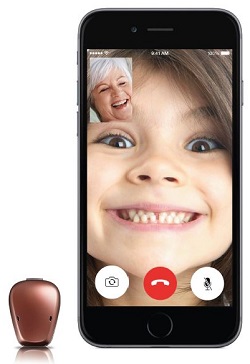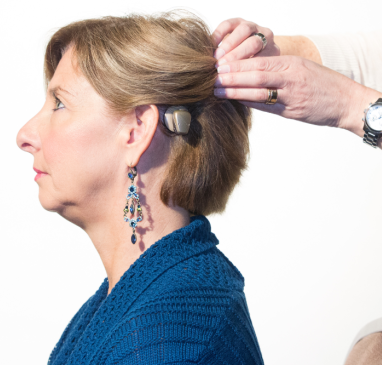Overview of the Features and Benefits of the New Cochlear™ Baha® 5 Sound Processor
Carolyn Smaka: Nice to speak with you again, George. Why did Cochlear develop the Baha 5 Sound Processor?

George Cire: The Cochlear™ Baha® 5 Sound Processor was designed to meet customers’ needs, including the need for a small and discreet processor, one that would adapt on the fly to the environment, and one that would improve handling and allow for connectivity to devices like smartphones.
Carolyn: How does the Baha 5 Sound Processor address those needs?
George: Baha 5 is the smallest and most discreet bone-anchored sound processor in the industry. It’s the first and only smart sound processor that allows the use of Bluetooth® Smart low energy technology. It was built on a new chip, the Ardium® 2, which features automatic signal processing with our proprietary SmartSound® iQ technology.
In addition, the Baha 5 Sound Processor has 2.4 GHz technology, and a Smart App portfolio that enables new features through direct-to-device streaming from iPhone®, iPad® and iPod touch®.*
We also released new fitting software that is dedicated to the Baha 5 Sound Processor. It has an improved workflow and a new graphical user interface to make the programming and fitting process much easier for clinicians.
Carolyn: That is a lot of news! Let’s start with the Smart App. What does that offer to patients?
George: The Smart App portfolio allows for the use of the iPhone, iPad and iPod touch (iOS 8.0 and above) to be the remote control of the Baha 5 Sound Processor, and at the same time it allows for features like personalized custom programming. Now, the individual user can take control of the program that was decided upon by the clinician, adjust treble and bass with the Smart App for specific scenes and situations, and geotag that location via GPS on the iPhone. If the location is somewhere that the individual attends on a recurring basis, such as a favorite restaurant or meeting, and push notifications are enabled on the phone, it will send a notification that a custom program is available for this location. It will ask, “Would you like to access the custom program?”, and by simply hitting “yes”, the device will change to the individualized, custom setting.

The Smart App portfolio allows for the use of the iPhone, iPad and iPod touch (iOS 8.0 and above) to be the remote control of the Baha 5 Sound Processor.
Carolyn: What other features are possible with the new Smart App portfolio?
George: With the iPhone technology, you can actually find your Baha 5 Sound Processor by utilizing the “Find your Processor” function. The device will actually remember where it was using Google maps the last time you had the device on. If the sound processor is on, the feature will tell you if you are “warm” and “cold” on a small bar graph, so that you can locate your processor if you’ve misplaced it. This is another exciting and practical use of this new technology.
There is a native feature built into the iPhone called Live Listen. This feature turns your iPhone into a remote microphone for your Baha 5 Sound Processor. Since most people always have their cell phones handy, you now always have the option of using a remote microphone with the Baha 5, without having to worry about carrying around extra hardware. The cell phone has become a very interesting and practical tool to integrate with the sound processor to provide options for patients in a variety of listening situations.
Carolyn: It sounds like although the Baha 5 Sound Processor is much more sophisticated from the technology side than its predecessor, it’s also simpler to use.
George: Absolutely. That was the primary design function that we wanted to build into this; we wanted it to be simple and easy to use, but at the same time gave patients optimum hearing performance.
We recognize that technology is only as good as the patient’s willingness to access that technology. Multiple programs that the patient has to remember and then manually switch to can be a little daunting. Utilizing the features of the Ardium 2 chip, the Baha 5 Sound Processor allows for a smart, basic everyday program using scene analysis from SmartSound® iQ. SmartSound® iQ adjusts on the fly as the patient moves from one place to another, automatically, and without any intervention on behalf of the patient. The automatic feature allows the patient to live their life to the fullest and have the device be optimized as they move in and out of these various listening situations. That translates into quite a bit of value and benefit for the end user. For those who want the ability to override that and control their devices we offer remote control functionality via the Smart App platform, or via a remote control accessory.

Baha 5 Sound Processor.
Carolyn: With hearing aids, the manufacturers offer different implementations of streaming from an iPhone and other devices; some are direct and some involve an intermediary device. How is streaming accomplished with 2.4 GHz technology in the Baha 5 Sound Processor?
George: Our proprietary 2.4 GHz radio frequency link provides direct-to-device streaming from iPhone, iPad and iPod touch. The other options that are available today are other types of frequency domains and also near-field magnetic induction. We’ve elected to use 2.4 GHz, and because it’s a very robust signal, it can be used in a very small form factor, and there is not a need for extra equipment such as a dongle or neck loop accessory. The signal is streamed directly to the Baha 5 Sound Processor.
The range is about seven meters or about 23 feet, and that’s in the usability range of what a typical user would need on an everyday basis.
Carolyn: Tell me about the new design.
George: As I mentioned, the Baha 5 Sound Processor is both the smartest and the smallest processor available. We have a new transducer design that we’ve built into the device that enables the sound processor to be 23 percent smaller than other bone-anchored processors available today. The new transducer technology also produces a much cleaner sound with 30 percent less distortion (Gustafsson, 2015). For the clinician, that translates to the same fitting range as our legacy processor, but with more gain accessible before distortion or feedback.
In addition to the smaller size, we streamlined the design, and rounded the corners. The result is a more appealing device overall in terms of cosmetics, as well as easier handling. We also added new colors that would more closely match hair colors in everyday use.
The design of the Baha 5 Sound Processor was driven by premarket testing. We looked at people’s preferences and focused on developing a design that would create excitement. When our Research and Applications group in Sweden presented the design of the Baha 5 Sound Processor to 52 patients, 92 percent of the patients preferred the look and feel of the Baha 5 Sound Processor over both the Baha 4 and the leading competitor’s sound processor.
Carolyn: I know when Cochlear launches new technology, it is often backwards compatible. Is that the case with the Baha 5 Sound Processor?
George: Yes, the Baha 5 Sound Processor is compatible with all Baha Systems - our percutaneous and transcutaneous solutions. It uses the same proven snap coupler that has been used historically. People who are fit with a Baha System can inquire with our customer service team about the potential to upgrade. In addition, if someone is using a Baha 4 and has wireless accessories, those accessories would be compatible with the Baha 5.
Carolyn: Where can professionals get up to speed on the Baha 5 Sound Processor and the new programming software?
George: We have two courses on AudiologyOnline – an overview of the Baha 5 Sound Processor and a course on programming and the new fitting software.
In addition, we have an extensive field sales force that has materials and can facilitate individual in-person trainings or GoToMeeting sessions, depending on what suits a professional’s or clinic’s needs. We have a variety of means to support the professional community in terms of education and training.
Carolyn: George, how many years have you been working now in the area of bone-anchored solutions?
George: I’ve been working in bone-anchored solutions for about 10 years now.
When you combine the new design of the Baha 5 Sound Processor with the features of the smart Ardium 2 chip including SmartSound iQ sound scene analysis, along with the Made for iPhone functionality, you’ll see why I am very excited about this particular product. It offers access to similar great technology and benefits that we have seen in hearing aids to patients that need bone-anchored solutions.
Carolyn: Thanks for the overview – we appreciate your time today.
For more information, professionals can visit www.cochlear.com/us or the Cochlear Expo Page on AudiologyOnline.
References
Gustafsson, J. (2015, January 14). BCDrive transducer performance versus conventional bone conduction transducer. Cochlear Technical Report.
*Apple, the Apple logo, FaceTime, iPhone, iPad and iPod touch are trademarks of Apple Inc., registered in the U.S. and other countries. App Store is a service mark of Apple Inc.
©Cochlear Limited 2015. All rights reserved. Hear now. And always and other trademarks and registered trademarks are the property of Cochlear Limited or Cochlear Bone Anchored Solutions AB. The names of actual companies and products mentioned herein may be the trademarks of their respective owners.


